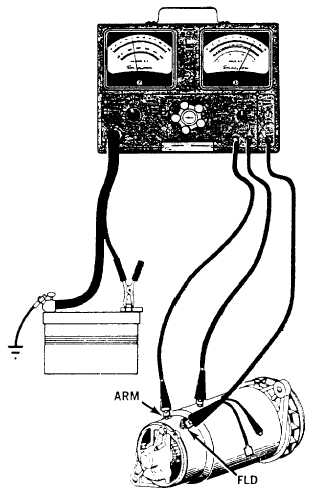connecting the field lead of the tester (fig. 4-10) to the generator field terminal. Do NOT allow the vehicle or tester field wires to contact ground. For the B type of field circuit generator, disconnect the field wire at the regulator and connect it to the armature terminal of the regulator. Then start the vehicle engine and slowly increase speed as you observe the AMMETER scale for the highest ammeter reading. When the ammeter reads at the normal output, test the field lead of the wiring harness for an open circuit. If the field lead is okay, remove the regulator for testing, repair, or replacement, as required. When the ammeter reads at low output or normal voltage, the generator must be replaced or repaired. When the ammeter reads at no output or high voltage and the circuit is not fused at the regulator, remove the regulator for replacement or repair of its cutout relay. Also check the regulator ground. If the regulator is fused, bypass the fuse with a heavy

Figure 4-10.-Generator output test.
jumper and observe the ammeter for output. An output at this point in your check indicates a blown fuse.
EXCESSIVE OUTPUT TEST
To conduct an excessive output test, set the volt range knob to the correct voltage range and the volt lead selector to the EXT VOLTS position. Connect the black external volts lead to the generator armature terminal and the red external volts lead to the generator frame or a good ground. While observing the VOLTMETER scale for the highest voltmeter reading, start the engine and slowly increase its speed. If the voltmeter reads less than 16 volts (12-volt system) or 8 volts (6-volt system), the current limiter relay of the regulator is the reason for the high output. If the voltmeter reads more than 16 volts (12-volt system) or 8 volts (6-volt system), remove the FIELD wire at the regulator and observe the AMMETER scale. When the ammeter reading shows no output, you have a defective regulator which should be repaired or replaced. When the ammeter reading indicates a current flow, remove the field wire at the generator and observe the ammeter. If the ammeter reading then shows no output, you have a shorted field wire. Replace the field wire and connect the generator to the regulator. On the other hand, if the ammeter shows that current is flowing, then the generator has a grounded field.
Another component of the vehicle charging system you should test is the VOLTAGE REGULATOR. If the results of the test indicate the voltage is too high or too low, a faulty regulator voltage limiter or a high-series resistance in the charging system could be causing the trouble. Erratic or unstable voltage indicates poor circuit electrical connections, faulty regulator contacts (burned or oxidized), or damaged regulator resistors. In any case, you should proceed with a charging system circuit resistance test.
CHARGING SYSTEM CIRCUIT RESISTANCE TEST
The purpose of the charging system circuit resistance test is to determine the voltage loss between the output terminal of the generator or alternator and the insulated battery post, and between the generator or alternator housing and battery ground post, respectively. These tests can be run with any voltmeter having a small scale; that is, 3-5 volts. Any voltage loss caused by high
Continue Reading